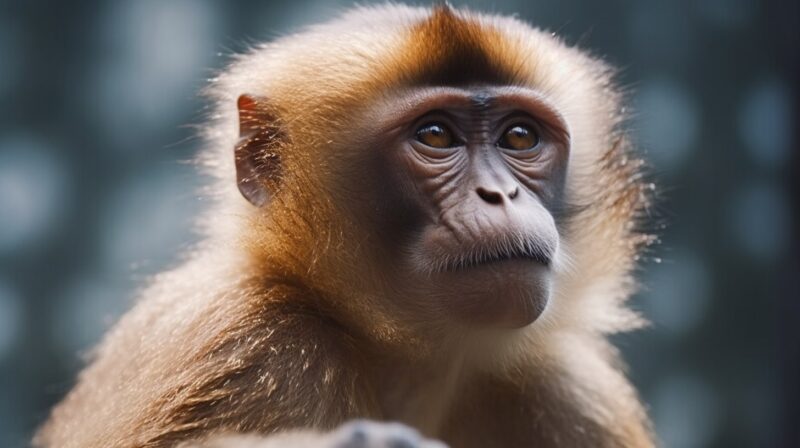Monkeys, with their playful antics and human-like features, have always captured our imagination. Many monkeys are known for their agility and speed, there are some that stand out for their leisurely pace, such as those mentioned in our article on the slowest animals in the world. While they are predominantly wild creatures, certain species have found their way into households as pets.
However, before embarking on the journey of pet monkey ownership, it’s vital to grasp their unique behaviors, needs, and the inherent challenges. In this article, we’ll delve into seven popular pet monkeys, highlighting their distinct characteristics accompanied by captivating visuals.
7. Guenons
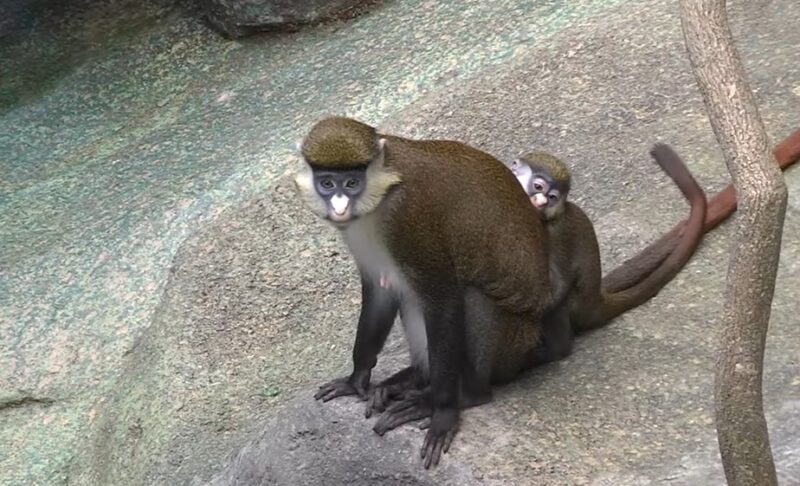
- Origin: Africa
Guenons are native to the vast and diverse continent of Africa. Their habitats span across the dense rainforests of Central and West Africa to the savannahs and grasslands of the East. This wide distribution across varied terrains has contributed to their adaptability and the development of their unique characteristics.
- Lifespan: Up to 25 years
In the wild, guenons face threats from predators, habitat loss, and diseases, which can impact their lifespan. However, in controlled environments like sanctuaries or when kept as pets, they can live up to 25 years. This extended lifespan is attributed to regular veterinary care, a balanced diet, and the absence of natural predators.
- Diet: Fruits, seeds, and insects
Guenons have a varied diet that reflects the rich biodiversity of their native habitats. They primarily feed on fruits, relishing the sweet and juicy treats that the African forests offer. Seeds form a crucial part of their diet, providing them with essential nutrients.
Additionally, they are opportunistic feeders, hunting down insects for protein. This varied diet not only nourishes them but also plays a role in seed dispersal, making guenons vital for their ecosystem.
- Size: 12 to 24 inches in length
The size of guenons can vary based on their species, age, and gender. On average, they range from 12 to 24 inches in length, excluding their tail. Their relatively compact size, combined with their agility, allows them to swiftly navigate the dense canopies of the African rainforests.
- Appearance and Behavior
Guenons are a visual treat, boasting vibrant colors and diverse facial patterns. Each species has its unique coloration, ranging from bright blues and greens to more muted browns and grays. These colors often play a role in communication, mating, and camouflage.
While their appearance is captivating, their behavior is equally intriguing. Guenons are active creatures, displaying a high level of curiosity about their surroundings. This inquisitiveness, combined with their playful nature, makes them entertaining companions. However, potential owners and caregivers should be aware of their territorial tendencies.
Guenons establish and defend their territories fiercely. This territorial behavior can sometimes translate into aggression, especially towards unfamiliar humans or other animals. It’s a natural instinct, rooted in their need to protect their space, food sources, and group
While guenons are undoubtedly captivating, there are other creatures with appearances that might surprise you, some of which are often labeled as less conventionally attractive.
6. Spider Monkeys
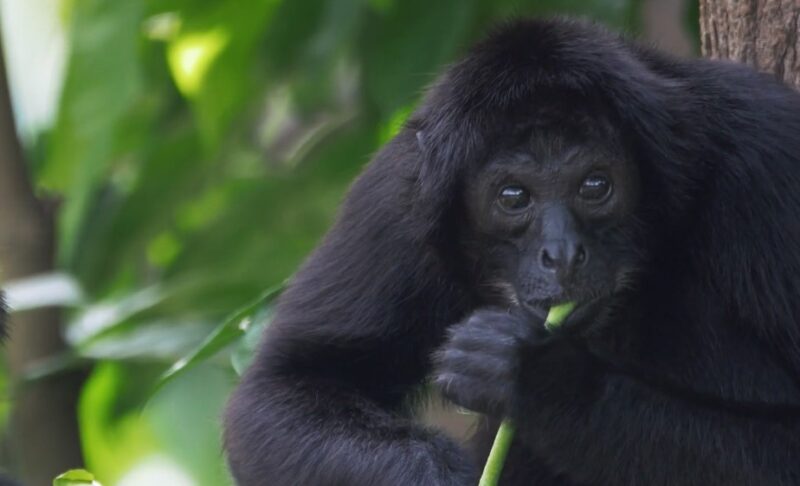
- Origin: Central and South America
Spider monkeys hail from the lush rainforests and tropical regions of Central and South America. These regions, rich in biodiversity, offer the perfect environment for these primates, with vast canopies to swing from and an abundance of food sources.
The diverse ecosystems of these areas have played a significant role in shaping the behaviors and adaptations of spider monkeys.
- Lifespan: Up to 25 years
In the dense jungles of Central and South America, spider monkeys face numerous challenges, from predators like jaguars and eagles to habitat destruction due to deforestation. Despite these threats, they have a remarkable ability to survive, with some living up to 25 years.
In captivity or sanctuaries, where they are shielded from predators and receive regular medical care, their lifespan can extend, reflecting the resilience of this species.
- Diet: Primarily fruits
Spider monkeys are predominantly frugivorous, meaning their diet consists mainly of fruits. The tropical forests they inhabit are teeming with a variety of fruits, providing them with a rich and diverse diet.
These fruits supply them with the necessary nutrients and energy to sustain their active lifestyles. Occasionally, they might supplement their diet with leaves, flowers, and even small insects, but fruits remain their primary source of sustenance.
- Size: 16 to 24 inches in length
Spider monkeys possess a slender and agile physique, typically measuring between 16 to 24 inches in length, excluding their long, prehensile tails. This tail acts as a fifth limb, providing balance and support as they navigate the treetops. Their size, combined with their dexterity, makes them one of the most adept climbers among New World monkeys.
- Appearance and Behavior
Spider monkeys are easily recognizable by their long limbs, spindly fingers, and a tail that’s often longer than their body. This unique anatomy, reminiscent of a spider, is the origin of their name. Their fur can range from golden yellow to dark brown, depending on the species.
Behaviorally, spider monkeys are known for their playful and curious nature. They are highly social animals, often seen swinging through trees in large groups known as troops.
These troops have intricate social structures, with strong bonds formed between members. Their playful demeanor, however, is juxtaposed with their unpredictable moods, especially when they feel threatened or cornered.
In the wild, their survival depends on group dynamics, with each member playing a role in foraging, lookout duties, and caring for the young. This inherent need for social interaction remains even when they are domesticated, emphasizing the importance of companionship and social enrichment for captive spider monkeys.
5. Macaques
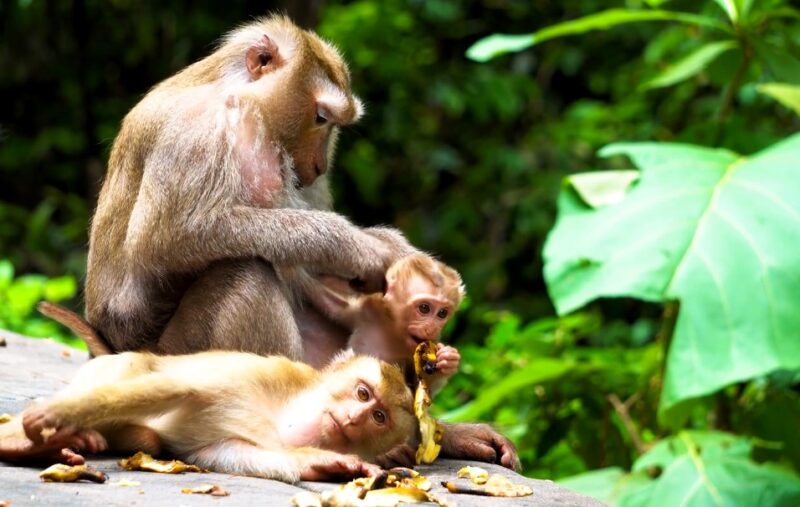
- Origin: Asia and North Africa
Macaques have carved out homes in the diverse terrains of Asia and North Africa, ranging from the dense jungles of Southeast Asia to the arid landscapes of North Africa. This wide geographical distribution has not only contributed to their adaptability but has also made them a subject of interest for researchers and wildlife enthusiasts alike.
- Lifespan: Up to 30 years
Navigating the challenges of the wild, from natural predators to human-induced threats, macaques have showcased remarkable resilience. In their natural settings, they can live for up to three decades, a testament to their adaptability and survival instincts. In captivity, where threats are minimized and regular care is provided, they often reach their maximum lifespan, reflecting their robust nature.
- Diet: Omnivorous
One of the keys to the macaque’s widespread distribution is their flexible diet. As omnivores, they feast on a mix of fruits, seeds, and small animals. This dietary adaptability means they can sustain themselves in varied habitats, whether it’s a fruit-rich forest or a region where insects and small vertebrates are the primary food sources.
- Size: Varies by species
The macaque family is diverse, with size being one of the most noticeable variations among different species. Typically, they can range anywhere from 16 to 28 inches in length, excluding their tails. This variation is often a reflection of their specific habitats and the evolutionary demands of each region they inhabit.
- Appearance and Behavior
Macaques are a visual delight, with each species presenting its unique set of features. Some are adorned with thick fur, while others have distinct facial markings. Their expressive faces, capable of displaying a wide range of emotions, are a window into their intricate social world.
In terms of behavior, macaques are multifaceted. They live in well-structured social groups, often with a clear hierarchy. Their interactions within these groups can range from affectionate grooming sessions to power displays.
While they are known to form close bonds with troop members, they can also exhibit dominant and sometimes aggressive behaviors, especially during mating seasons or territorial disputes.
Their interactions with humans are equally complex. In areas where they have become accustomed to human presence, macaques can be bold, often approaching people out of curiosity or in search of food. However, their dominant and unpredictable nature makes them a challenging choice for those considering them as pets.
4. Tamarins
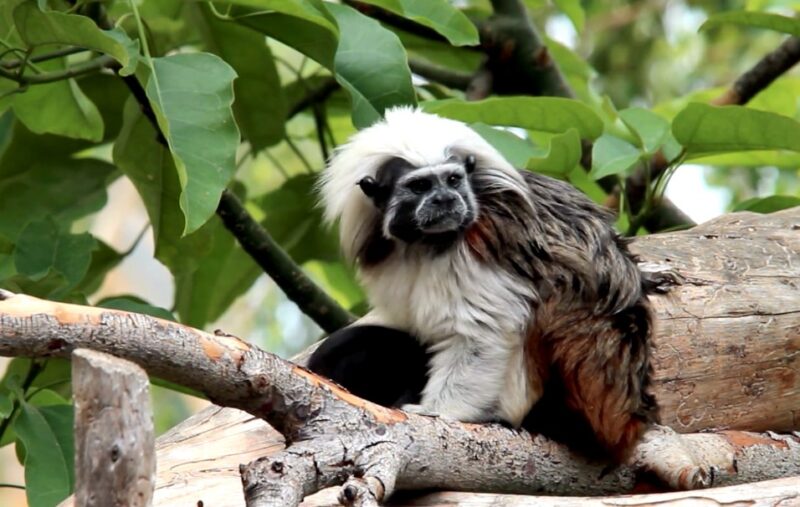
- Origin: Central and South America
Tamarins trace their roots to the lush rainforests and diverse ecosystems of Central and South America. These regions, abundant in flora and fauna, provide the ideal backdrop for the tamarin’s vibrant life. The dense canopies and intricate undergrowth offer them both shelter and a rich hunting ground, shaping their behaviors and lifestyles.
- Lifespan: Up to 18 years
In the wild, tamarins face a series of challenges, from deforestation to natural predators like birds of prey. Yet, their agility and keen senses often allow them to evade threats, leading to a lifespan that can stretch up to 18 years.
In controlled environments, such as zoos or conservation centers, where they are shielded from predators and receive consistent care, they often reach or even surpass this age.
- Diet: Fruits, flowers, and insects
Tamarins have a varied and balanced diet, a reflection of the biodiversity of their habitats. They primarily feast on fruits, savoring the sweet and tangy flavors of the rainforest’s bounty. Flowers, with their nectar, provide another source of nutrition. Additionally, tamarins are adept hunters, preying on insects for protein, which adds a crucial component to their diet.
- Size: 7 to 11 inches in length
Compact yet agile, tamarins typically measure between 7 to 11 inches in length, not counting their long, expressive tails. This size makes them one of the smaller primate species, but what they lack in stature, they more than make up for in personality and vitality.
- Appearance and Behavior
Tamarins are undeniably striking. Their most distinctive feature is their mustache-like facial hair, which varies in prominence across different species. This, combined with their elongated tails and bright eyes, makes them one of the most recognizable primates in the Americas.
Behaviorally, tamarins are a bundle of energy. They are agile climbers, often seen darting through the treetops or playfully chasing one another. Their social nature is evident in their daily interactions.
Much like marmosets, their close relatives, tamarins are inherently social creatures. They form tight-knit groups in the wild, often centered around familial bonds. These bonds are crucial for their survival, offering protection and aiding in foraging.
When it comes to companionship, tamarins place immense value on it. They thrive best when in pairs or groups, emphasizing the significance of social bonds. In captivity, this need for companionship becomes even more pronounced, as isolation can lead to stress and behavioral issues.
3. Marmosets
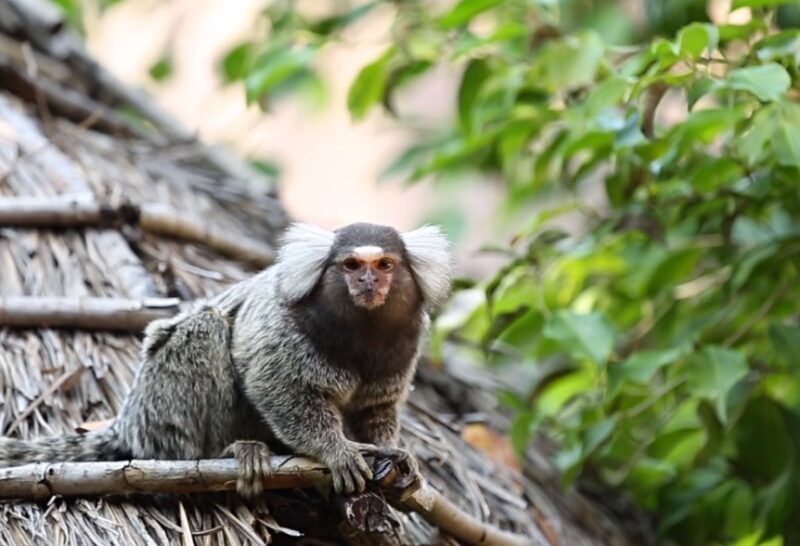
- Origin: South America
Nestled in the dense rainforests and vibrant ecosystems of South America, marmosets have evolved and thrived. These regions, teeming with life and offering a plethora of resources, have been instrumental in shaping the marmoset’s unique characteristics and behaviors.
The lush green canopies and intricate forest floor provide both a playground and a hunting ground for these petite primates.
- Lifespan: 12 to 16 years
In their natural habitats, marmosets face various challenges, from larger predatory birds to habitat disruption due to human activities. Despite these adversities, their agility, sharp senses, and adaptability allow them to navigate the complexities of the wild, leading to a lifespan that can span between 12 to 16 years.
In controlled environments, such as homes or sanctuaries, where they receive consistent care and face fewer threats, they often reach the upper end of this age range.
- Diet: Insects, fruits, and tree sap
Marmosets have a diverse palate, reflecting the rich biodiversity of their native habitats. They are adept insect hunters, using their sharp vision and nimble fingers to catch these protein-rich morsels. Fruits, with their abundance in the rainforests, offer a sweet and nutritious component to their diet.
Additionally, marmosets have a unique dietary preference: tree sap. They use their sharp teeth to gnaw on tree bark, allowing them to lap up the oozing sap, which provides them with essential nutrients and calories.
- Size: 5 to 8 inches in length
Marmosets are among the smallest members of the primate family, typically measuring a mere 5 to 8 inches in length, excluding their tails. Their diminutive size, combined with their lively nature, makes them both adorable and fascinating to observe.
- Appearance and Behavior
Marmosets are a visual treat. Their soft, often multicolored fur, combined with their expressive faces, sets them apart from many other primates. Their tiny fingers, used for both foraging and climbing, are a testament to their adaptability.
Behaviorally, marmosets are social butterflies. They thrive in familial groups in the wild, forming intricate social structures. These structures play a pivotal role in their survival, from collective foraging efforts to protection against predators.
Their social nature is so ingrained that when in captivity, the importance of companionship cannot be overstated. Regular social interactions are vital for their mental well-being.
Furthermore, their natural habitat in the rainforests has made them exceptional climbers. They are accustomed to a vertically-rich environment, darting up and down trees with ease. This innate climbing instinct means that any habitat designed for them, whether in zoos or homes, should offer ample vertical space to satisfy their climbing needs.
2. Squirrel Monkeys
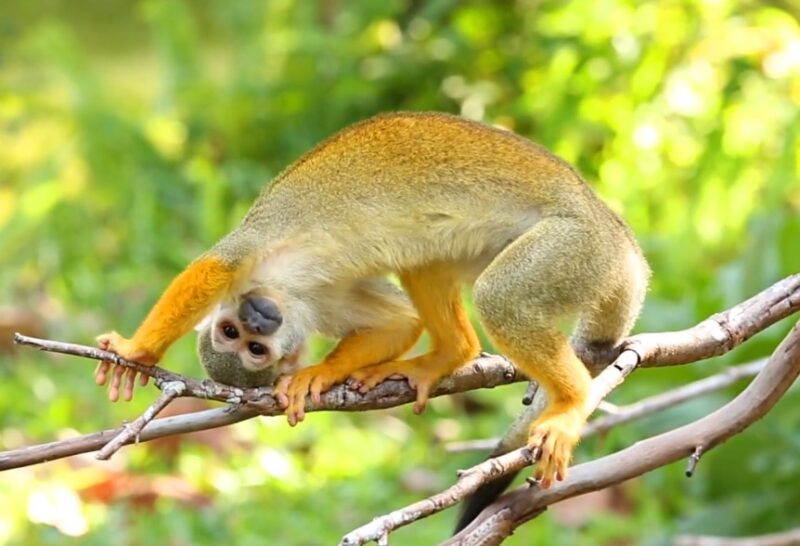
- Origin: Central and South America
Squirrel monkeys have made their home amidst the lush rainforests and diverse terrains of Central and South America. These vibrant ecosystems, abundant in flora and fauna, provide the perfect backdrop for the squirrel monkey’s lively existence. The dense canopies and intricate undergrowth serve as both a sanctuary and a playground for these animated primates.
- Lifespan: 15 to 20 years
Navigating the challenges of the wild, from aerial predators to habitat disturbances, squirrel monkeys showcase commendable resilience. Their keen senses and agility often allow them to evade threats, leading to a lifespan that can span between 15 to 20 years.
In controlled environments, such as conservation centers or homes, where they receive regular care and are shielded from natural predators, they often approach or even surpass the upper limit of this age range.
- Diet: Mainly fruits and insects
Squirrel monkeys have a diet that mirrors the richness of their habitats. They primarily feast on fruits, savoring the diverse flavors that the rainforests offer. Insects, rich in protein, form another crucial component of their diet.
Their sharp eyes and nimble fingers make them adept at catching these quick-moving morsels, ensuring a balanced intake of nutrients.
- Size: 10 to 14 inches in length
Squirrel monkeys, while not the smallest of primates, are compact and agile. Typically, they measure between 10 to 14 inches in length, excluding their tails. This size, combined with their lightweight build, allows them to move swiftly through the treetops, making them a captivating sight in their natural habitats.
- Appearance and Behavior
Squirrel monkeys are a feast for the eyes. Their most distinctive features are their bright yellow legs and the white borders around their eyes, which stand out against their olive or greyish-green fur. These features not only add to their visual appeal but also play a role in their social interactions and mating rituals.
Behaviorally, squirrel monkeys are a bundle of energy. They are agile climbers and jumpers, often seen darting through the rainforest canopy or playfully interacting with their troop members. Their social nature is evident in their daily activities, from grooming sessions to collective foraging expeditions.
However, one of the most notable characteristics of squirrel monkeys is their vocal nature. They have a wide range of calls, from chirps to screeches, which they use for communication, whether to alert the troop of potential dangers or to establish dominance. This vocal behavior, while fascinating, can be quite pronounced, making them a handful for potential pet owners.
1. Capuchin Monkeys
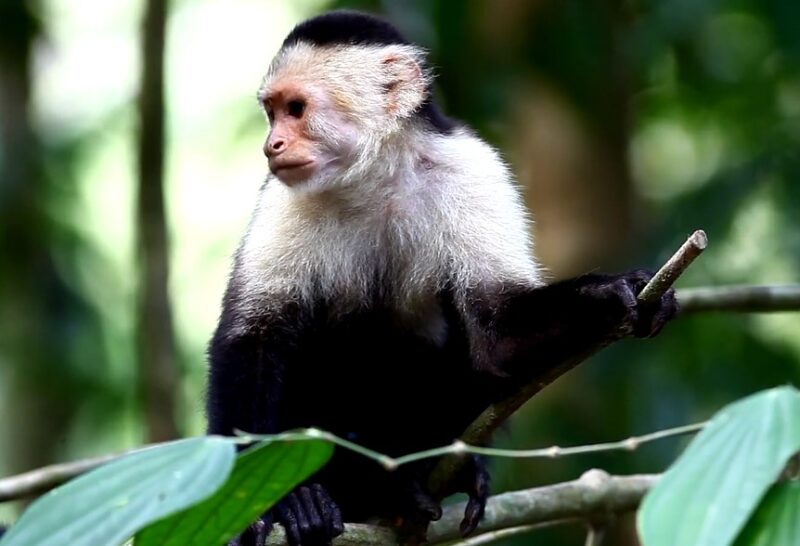
- Origin: Central and South America
Capuchin monkeys have carved out a niche for themselves in the diverse landscapes of Central and South America. From the thick rainforests of the Amazon basin to the varied terrains of Central America, these regions, rich in biodiversity, have played a pivotal role in shaping the capuchin’s unique characteristics and behaviors.
The lush greenery and intricate ecosystems offer both sustenance and shelter to these intelligent primates.
- Lifespan: Up to 40 years in captivity
In the wild, capuchins face numerous challenges, from natural predators like large birds of prey to human-induced threats such as habitat destruction. However, their intelligence and adaptability often allow them to navigate these challenges, leading to a respectable lifespan.
Remarkably, in controlled environments like zoos, sanctuaries, or even homes, where they receive consistent care and face fewer threats, capuchins can live up to 40 years, showcasing their resilience.
- Diet: Omnivorous
Capuchins have a diverse diet that reflects their intelligence and adaptability. As omnivores, they consume a mix of fruits, insects, and small vertebrates. Their sharp cognitive abilities aid them in devising strategies to hunt or forage, ensuring a balanced and nutritious intake.
Whether it’s extracting insects from tree barks using tools or hunting down small vertebrates, their dietary habits are a testament to their resourcefulness.
- Size: 12 to 22 inches in length
Capuchins, with their robust build, typically measure between 12 to 22 inches in length, not counting their expressive tails. This tail, often used for balance and grip, further aids their agility, allowing them to navigate the dense canopies of their habitats with ease.
- Appearance and Behavior
Capuchins are instantly recognizable, often due to their frequent appearances in media. Their white-faced appearance, accentuated by tufted hair, gives them a distinctive look that sets them apart from many other primates. This unique appearance, combined with their expressive eyes, often makes them a favorite subject for photographers and filmmakers.
Behaviorally, capuchins are a marvel. Their intelligence is evident in their daily activities, from problem-solving to social interactions. They are known to use tools, showcase advanced planning, and even exhibit traits of self-recognition.
Socially, they thrive in groups, forming intricate hierarchies and bonds. This inherent social nature means they require extensive interaction and stimulation, both mentally and physically.
However, like many intelligent beings, capuchins come with their set of challenges. They can exhibit aggressive behaviors, especially during their adolescent phase, a time marked by hormonal changes and the establishment of social ranks. This aggression, while natural, can make them a handful for caregivers and emphasizes the importance of understanding their needs and behaviors.
Monkeys are also very popular as pets because they are intelligent and very interesting. If you also like pet monkeys very much or are looking for a gift for a friend who likes pet monkeys, then custom enamel pins are a good choice.
You can customize the images of some pet monkeys into enamel pins as gifts for friends. Exquisite custom enamel pins are versatile and are great as decoration or collection. Of course, as a parent, you can also customize monkey-related enamel pins to give to your children. Adding the name of the monkey species on it can help them remember it quickly, this is a gift that will impress them. To learn more, click EnamelPins.com.
FAQs
What are the origins of the seven popular pet monkeys mentioned?
The origins vary:
- Guenons: Africa
- Spider Monkeys: Central and South America
- Macaques: Asia and North Africa
- Tamarins: Central and South America
- Marmosets: South America
- Squirrel Monkeys: Central and South America
- Capuchin Monkeys: Central and South America
How long can guenons live in captivity?
In controlled environments like sanctuaries or when kept as pets, guenons can live up to 25 years.
What is the primary diet of spider monkeys?
Spider monkeys are predominantly frugivorous, meaning their diet consists mainly of fruits.
Are macaques suitable to be kept as pets?
Macaques can be dominant and unpredictable, especially during mating seasons or territorial disputes. Their interactions with humans can be complex, making them a challenging choice for pet ownership.
What makes tamarins unique in appearance?
Tamarins are known for their mustache-like facial hair, which varies in prominence across different species.
How do marmosets extract tree sap from trees?
Marmosets use their sharp teeth to gnaw on tree bark, allowing them to lap up the oozing sap.
Why are squirrel monkeys called “vocal”?
Squirrel monkeys have a wide range of calls, from chirps to screeches, which they use for communication, alerting the troop of potential dangers, or establishing dominance.
What sets capuchin monkeys apart in terms of intelligence?
Capuchins are known to use tools, showcase advanced planning, and even exhibit traits of self-recognition, making them one of the most intelligent primates.
Are there any legal considerations to keep in mind before owning a monkey as a pet?
Yes, it’s crucial to be aware of local regulations pertaining to primate ownership. Before considering one as a pet, thorough research on the chosen species and understanding of their requirements are paramount.
Conclusion
Monkeys, while enchanting, come with a set of intricate needs. Before considering one as a pet, thorough research on the chosen species, an understanding of their requirements, and a commitment to providing an appropriate environment are paramount.
Additionally, it’s crucial to be aware of local regulations pertaining to primate ownership. Ultimately, these wild creatures are best admired in their natural settings or sanctuaries dedicated to their well-being.


